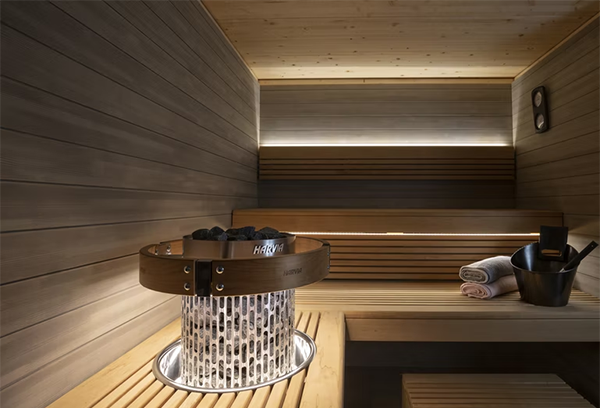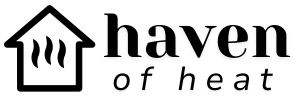Las paredes son uno de los componentes principales de una sauna. Un aislamiento adecuado es fundamental para retener el calor y la humedad, lo que crea una experiencia de sauna eficiente y agradable. En este artículo, analizaremos en profundidad todo lo que necesita saber sobre el aislamiento de la sauna.
Comprender las necesidades de aislamiento de la sauna
Las saunas plantean desafíos de construcción únicos debido a sus altas temperaturas, que alcanzan hasta 120 °C, y a los altos niveles de humedad cuando se arroja agua sobre las rocas. Para retener el calor y la humedad, existen dos opciones principales: utilizar troncos de madera maciza gruesos o crear un "sándwich" de aislamiento y membranas dentro de una pared con estructura de madera. Como arquitecto, recomiendo esta última opción por varias razones:
-
Eficiencia en el uso del material: Limita la cantidad de madera requerida.
-
Rendimiento térmico superior: proporciona mejores valores U y R que las construcciones de troncos sólidos del mismo espesor.
-
Ahorro de espacio: permite paredes más delgadas, conservando espacio.
Barrera de vapor para pared de sauna
Para retener la humedad de manera eficaz, es esencial una barrera de vapor no transpirable. Las barreras de vapor de aluminio son ideales porque el aluminio se derrite a temperaturas más altas, lo que evita la emisión de gases nocivos. La mejor opción es una barrera de aluminio con respaldo de papel, que ofrece soporte adicional y refleja el calor radiante hacia la sauna, lo que contribuye a la eficiencia energética. Asegúrese de sellar todas las juntas para evitar que la humedad ingrese a la cavidad de la pared, ya que el aislamiento húmedo pierde sus propiedades térmicas.

Materiales de aislamiento para paredes de sauna
Elegir el material de aislamiento adecuado es fundamental para mantener el calor en el interior de la sauna. A continuación, se detallan las distintas opciones:
-
Lana mineral (fibra):
-
Ventajas: Alto punto de fusión (~2150 °F o 1177 °C), relativamente económico, tableros semirrígidos para fácil instalación.
-
Rendimiento: Una capa de 4 pulgadas (100 mm) con un valor K de 0,035 proporciona un valor R de 2,8, suficiente para una sauna al aire libre.
-
Celulosa:
-
Ventajas: Respetuoso con el medio ambiente, fabricado con papel reciclado y fibras de madera.
-
Contras: Pierde propiedades aislantes cuando está húmedo, relativamente resistente al fuego debido al sodio añadido.
-
Fardos de paja:
-
Ventajas: Baja huella de CO2, relativamente barato.
-
Contras: Es difícil encontrar proveedores o contratistas con experiencia con este material.
-
Cáñamo:
-
Ventajas: Material aislante natural.
-
Contras: Propenso a la retención de humedad, requiriendo barreras de vapor bien selladas.
-
Fibras naturales (algodón, lana):
-
Ventajas: No irritante, viene en rollos o paquetes.
-
Contras: Más caro que otras opciones como la lana mineral o la fibra de vidrio.
Materiales de aislamiento no recomendados
-
Poliuretano:
-
Contras: Contiene agentes espumantes y retardantes de llama potencialmente dañinos.
-
Poliisocianurato (PIR):
-
Contras: Libera altos niveles de productos tóxicos cuando se quema, según un estudio de 2011 del Centro de Ciencias de Incendios y Riesgos de la Universidad de Central Lancashire.

Aislamiento de paredes de sauna: paso a paso
Paso 1: Preparar las paredes
- Enmarcar las paredes y el techo de la sauna, asegurando un espacio uniforme para la colocación del aislamiento.
Paso 2: Instalar el aislamiento
- Corte el aislamiento para que encaje perfectamente entre los montantes. Para materiales como lana mineral, use equipo de protección para evitar irritaciones.
Paso 3: Aplicar barrera de vapor
- Cubre el aislamiento con una barrera de vapor de aluminio con respaldo de papel. Asegúrate de que todas las uniones estén selladas con cinta adhesiva para evitar la entrada de humedad.
Paso 4: Instalar el revestimiento interior
- Agregue un revestimiento de madera resistente al calor (como cedro o álamo temblón) en el interior, que protege el aislamiento y mejora la estética de la sauna.
Cálculo del rendimiento térmico
Valor K: indica la capacidad de un material para conducir el calor. Los valores más bajos son mejores para el aislamiento. Valor R: representa la resistencia térmica. Se calcula como R = Espesor / Valor K. Valor U: mide la pérdida total de calor. Los valores U más bajos indican un mejor rendimiento del aislamiento.
Beneficios de un aislamiento adecuado de la sauna
-
Eficiencia energética: Reduce los costes de calefacción al retener el calor de forma más eficaz.
-
Comodidad: Garantiza una temperatura estable y confortable durante el uso.
-
Durabilidad: protege la integridad estructural al evitar daños por humedad.
-
Calentamiento rápido: permite que la sauna alcance las temperaturas deseadas más rápido.
Preguntas frecuentes sobre el aislamiento de paredes de sauna
P: ¿Puedo utilizar material aislante doméstico común para mi sauna? R: Es mejor utilizar materiales aislantes diseñados para entornos con altas temperaturas para garantizar la seguridad y la eficiencia.
P: ¿Qué espesor debe tener el aislamiento de la sauna? R: Por lo general, basta con 4 pulgadas de lana mineral. Para climas más fríos, considere 6 pulgadas.
P: ¿Es necesario aislar el suelo de la sauna? R: El aislamiento del suelo puede mejorar la retención del calor, especialmente en las regiones más frías, pero no siempre es necesario.
Envolviéndolo
Aislar adecuadamente las paredes de la sauna es esencial para una experiencia eficiente y agradable. Si elige los materiales adecuados y sigue las mejores prácticas, podrá crear una sauna que sea cómoda y a la vez eficiente en términos de energía. Para un rendimiento óptimo, utilice una placa rígida de lana mineral de 4 pulgadas y una barrera de vapor de aluminio de alta calidad con costuras selladas.
¿Quieres que diseñemos tu sauna completa gratis (y te proporcionemos todos los materiales)?









Dejar un comentario